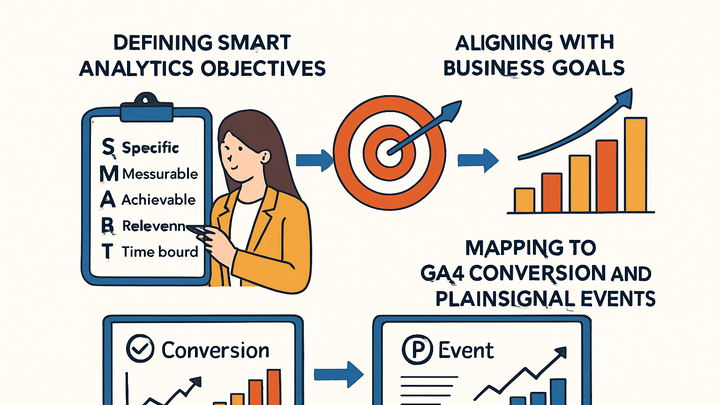Published on 2025-06-22T04:04:07Z
What is an Analytics Objective? Examples in GA4 and PlainSignal
An analytics objective is a defined goal that guides which metrics to track and analyze to inform business decisions. By establishing clear objectives, organizations ensure their data efforts align with key priorities and can measure success quantitatively. Objectives help turn raw data into actionable insights, focusing on outcomes such as increasing user engagement, boosting conversion rates, or improving retention. In tools like Google Analytics 4 (GA4) and PlainSignal, objectives translate into specific events, conversions, or key metrics to monitor. Using SMART criteria—Specific, Measurable, Achievable, Relevant, and Time-bound—ensures objectives are actionable and realistic. Well-defined objectives provide direction for reporting structures, dashboard design, and ongoing optimization across any analytics workflow.
Objective
A measurable, time-bound goal guiding which metrics to track and analyze in platforms like GA4 and PlainSignal.
Importance of Objectives in Analytics
Objectives serve as the foundation of any analytics strategy. They ensure that data collection, reporting, and analysis focus on what matters most to the business.
-
Alignment with business goals
Objectives connect your analytics setup to broader company aims—whether it’s revenue growth, user retention, or customer satisfaction.
-
Focused data collection
With clear objectives, you avoid data overload by collecting only the events and metrics that drive insights toward your goals.
-
Actionable insights
Well-defined objectives translate raw numbers into a narrative that stakeholders can act upon to optimize campaigns, UX, or product features.
Defining Effective Analytics Objectives
Use the SMART framework to turn vague aspirations into concrete analytics objectives that guide measurement and reporting.
-
Smart criteria
Ensure each objective is Specific, Measurable, Achievable, Relevant, and Time-bound.
-
Specific
Define exactly what you want to measure (e.g., ‘Increase trial sign-ups’).
-
Measurable
Attach a quantifiable metric (e.g., ‘by 20%’).
-
Achievable
Set realistic targets based on historical performance.
-
Relevant
Tie the objective directly to a strategic business need.
-
Time-bound
Specify a deadline (e.g., ‘within the next quarter’).
-
Implementing Objectives in Analytics Platforms
Once objectives are defined, translate them into platform-specific configurations to track progress automatically.
-
Tracking objectives in GA4
In Google Analytics 4, objectives become conversion events and custom dimensions.
-
Set up conversion events
Mark key events—like form submissions or purchases—as conversions in the GA4 interface.
-
Use explorations
Build custom Exploration reports to analyze objective progress over time.
-
-
Tracking objectives in PlainSignal
PlainSignal offers cookie-free, privacy-first tracking ideal for monitoring objectives simply.
-
Embed the tracking code
<link rel="preconnect" href="//eu.plainsignal.com/" crossorigin /> <script defer data-do="yourwebsitedomain.com" data-id="0GQV1xmtzQQ" data-api="//eu.plainsignal.com" src="//cdn.plainsignal.com/plainsignal-min.js"></script> -
Define key events
Tag user actions—like button clicks or form completions—and watch progress in PlainSignal’s dashboard.
-
Examples of Common Analytics Objectives
Real-world examples to inspire your own analytics goals.
-
Increase free trial sign-ups by 25%
Track the ‘start_trial’ event and measure monthly growth against a 25% uplift goal.
-
Boost e-commerce conversion rate by 1.5%
Monitor purchase completions as conversions in GA4 and compare cohort behavior after UX tweaks.
-
Reduce cart abandonment by 10% in 3 months
Use a combination of GA4 funnels and PlainSignal event tracking to identify drop-off points.
